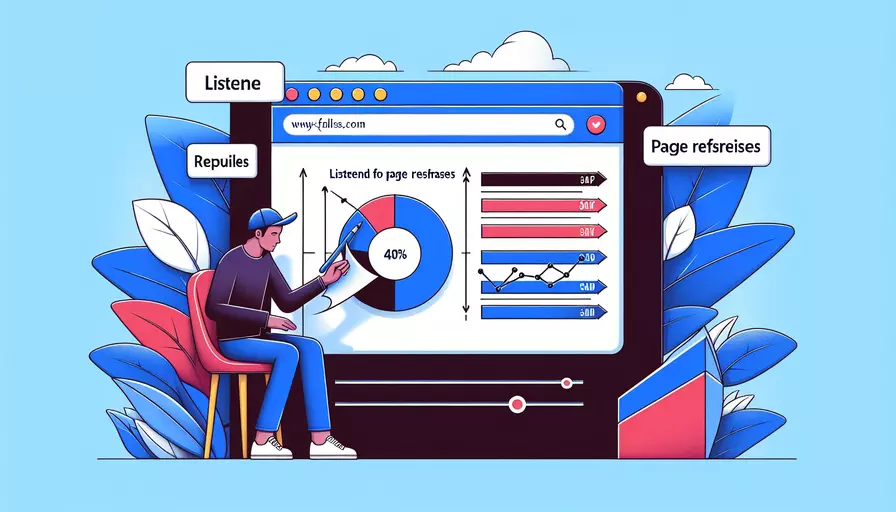
在Vue组件中,我们可以通过几种方式来监听页面的刷新事件:1、使用beforeunload事件监听,2、使用created生命周期钩子监听,3、使用mounted生命周期钩子监听。其中,使用beforeunload事件监听是一种常见且有效的方法。
使用beforeunload事件监听:这一方法通过在全局范围内监听浏览器的beforeunload事件,可以检测到页面刷新、关闭或跳转等情况。我们可以在Vue组件的mounted生命周期钩子中添加该事件监听,并在beforeDestroy钩子中移除监听,以确保不会发生内存泄漏。
一、使用beforeunload事件监听
- 在mounted生命周期钩子中添加beforeunload事件监听:
mounted() {
window.addEventListener('beforeunload', this.handleBeforeUnload);
}
- 在beforeDestroy生命周期钩子中移除beforeunload事件监听:
beforeDestroy() {
window.removeEventListener('beforeunload', this.handleBeforeUnload);
}
- 定义handleBeforeUnload方法:
methods: {
handleBeforeUnload(event) {
// 这里可以执行一些保存数据或清理操作
const confirmationMessage = '您确定要离开此页面吗?';
event.returnValue = confirmationMessage; // 标准兼容
return confirmationMessage; // 兼容部分浏览器
}
}
二、使用created生命周期钩子监听
在Vue组件的created生命周期钩子中,我们可以监听window对象的beforeunload事件,从而检测页面的刷新:
created() {
window.addEventListener('beforeunload', this.handleBeforeUnload);
}
methods: {
handleBeforeUnload(event) {
// 处理页面刷新前的逻辑
const message = '你确定要离开此页面吗?';
event.returnValue = message; // 标准兼容
return message; // 兼容部分浏览器
}
}
beforeDestroy() {
window.removeEventListener('beforeunload', this.handleBeforeUnload);
}
三、使用mounted生命周期钩子监听
在Vue组件的mounted生命周期钩子中,我们可以监听window对象的beforeunload事件,从而检测页面的刷新:
mounted() {
window.addEventListener('beforeunload', this.handleBeforeUnload);
}
methods: {
handleBeforeUnload(event) {
// 处理页面刷新前的逻辑
const message = '你确定要离开此页面吗?';
event.returnValue = message; // 标准兼容
return message; // 兼容部分浏览器
}
}
beforeDestroy() {
window.removeEventListener('beforeunload', this.handleBeforeUnload);
}
四、对比分析
| 方法 | 优点 | 缺点 |
|---|---|---|
| 使用beforeunload事件监听 | 简单直接,兼容性较好,能捕获各种页面离开事件 | 部分浏览器可能不支持自定义提示信息 |
| 使用created生命周期钩子监听 | 在组件创建时就能监听,可以处理一些初始化逻辑 | 需要在beforeDestroy中移除监听 |
| 使用mounted生命周期钩子监听 | 在DOM挂载后监听,可以处理与DOM相关的逻辑 | 需要在beforeDestroy中移除监听 |
通过上面的对比分析,我们可以看到,使用beforeunload事件监听是一种简单且有效的方法,能够捕获到各种页面离开事件,虽然部分浏览器可能不支持自定义提示信息,但在大多数情况下,它仍然是一个不错的选择。
总结
通过以上几种方法,我们可以有效地在Vue组件中监听页面的刷新事件。使用beforeunload事件监听是一种常见且有效的方式,同时在生命周期钩子中添加和移除事件监听,可以确保不会发生内存泄漏。根据具体需求选择合适的方法,可以帮助我们更好地处理页面刷新事件。在实际应用中,我们还可以结合其他技术手段,如使用LocalStorage或SessionStorage来保存用户状态,确保页面刷新后的数据恢复。希望这篇文章对你有所帮助,如果有任何疑问或建议,欢迎留言讨论。
相关问答FAQs:
1. 如何在Vue组件中监听页面刷新?
在Vue组件中,可以通过window对象的beforeunload事件来监听页面刷新。该事件在页面即将刷新时触发,我们可以在事件处理函数中执行相应的操作。
export default {
mounted() {
window.addEventListener('beforeunload', this.handlePageRefresh);
},
beforeDestroy() {
window.removeEventListener('beforeunload', this.handlePageRefresh);
},
methods: {
handlePageRefresh() {
// 在这里执行页面刷新时的操作
}
}
}
在上述代码中,我们使用了mounted钩子函数来添加beforeunload事件的监听器,并使用beforeDestroy钩子函数在组件销毁前移除监听器。在handlePageRefresh方法中,你可以执行你需要的操作,比如保存数据或者向后台发送请求。
2. 如何判断是页面刷新还是页面关闭?
在beforeunload事件处理函数中,可以通过判断event对象的returnValue属性来判断是页面刷新还是页面关闭。
export default {
mounted() {
window.addEventListener('beforeunload', this.handlePageRefresh);
},
beforeDestroy() {
window.removeEventListener('beforeunload', this.handlePageRefresh);
},
methods: {
handlePageRefresh(event) {
event.preventDefault();
if (event.returnValue) {
// 页面关闭
} else {
// 页面刷新
}
}
}
}
在上述代码中,我们通过调用event.preventDefault()来阻止页面的默认刷新或关闭操作。然后,通过判断event.returnValue属性的值来确定是页面刷新还是页面关闭。
3. 如何在页面刷新时提示用户是否保存修改?
在beforeunload事件处理函数中,可以使用confirm函数来显示一个确认框,询问用户是否保存修改。
export default {
mounted() {
window.addEventListener('beforeunload', this.handlePageRefresh);
},
beforeDestroy() {
window.removeEventListener('beforeunload', this.handlePageRefresh);
},
methods: {
handlePageRefresh(event) {
event.preventDefault();
if (event.returnValue) {
// 页面关闭
} else {
// 页面刷新
const message = '您是否要保存修改?';
event.returnValue = message;
return message;
}
}
}
}
在上述代码中,我们在页面刷新时设置了event.returnValue的值为提示信息,并返回该信息。这样,浏览器会在页面刷新时显示一个确认框,询问用户是否保存修改。用户可以选择保存或放弃修改。
文章标题:vue组件中如何监听页面刷新,发布者:worktile,转载请注明出处:https://worktile.com/kb/p/3681796

 微信扫一扫
微信扫一扫  支付宝扫一扫
支付宝扫一扫 